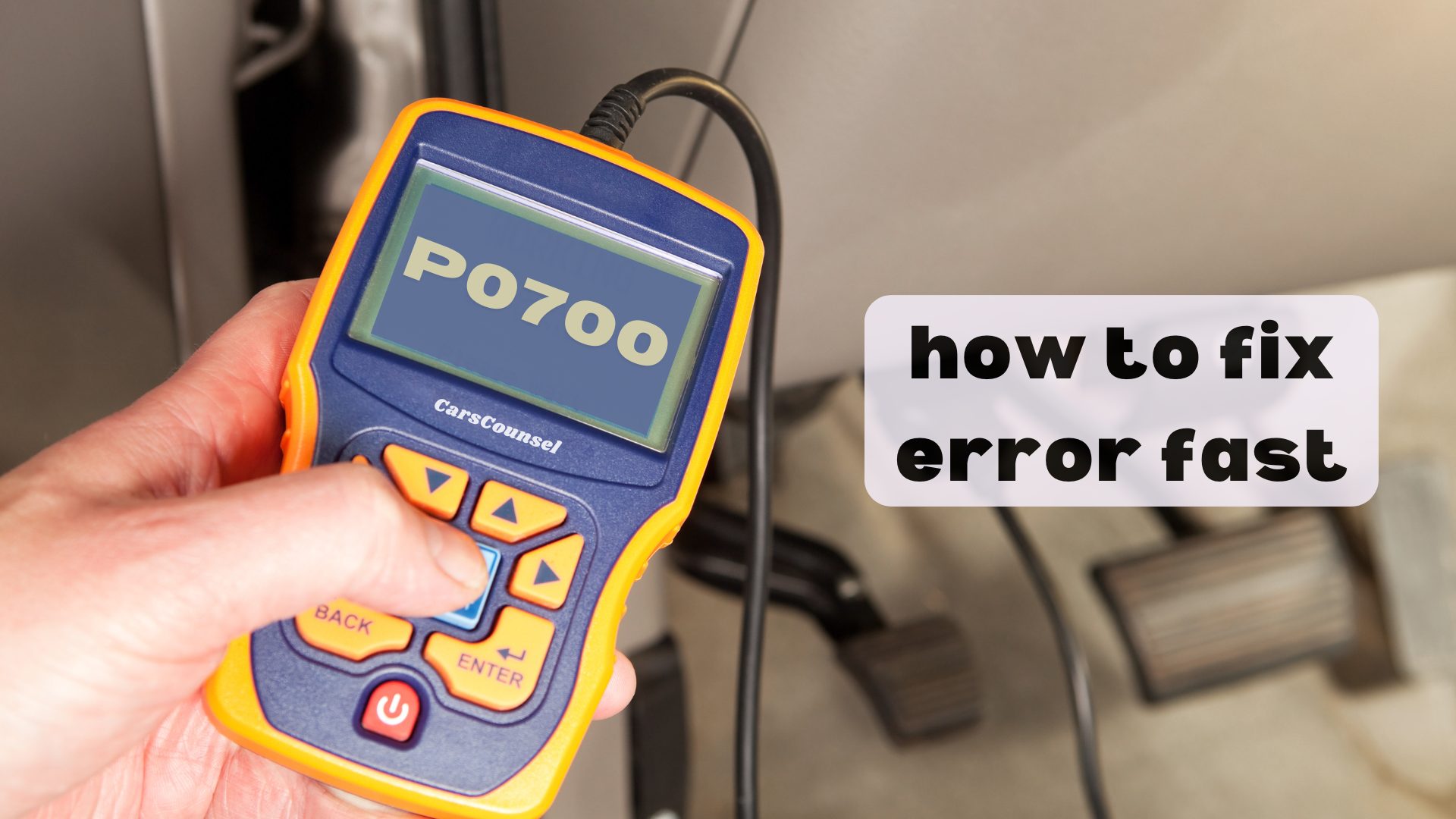When you see a P0700 code, it means there’s an issue with your car’s transmission control system and you should fix it quickly to avoid bigger problems.
Start by using an OBD-II scanner to check for any other related trouble OBD2 Codes.
Then, make sure your transmission fluid is clean and at the right level, because dirty or burnt fluid might need replacing.
Also, check the wiring and connections for any signs of damage or corrosion.
Want to know what else might be causing the problem? Let’s look into some more steps to get your car back on the road.

Quick Navigation
Key Takeaways
How to Quickly Fix a P0700 Code
- Use an OBD-II Scanner: Get an OBD-II scanner to find out the exact problem codes and understand what’s going wrong with your transmission.
- Check Transmission Fluid: Make sure the transmission fluid is at the right level and isn’t dark or burnt. If it is, change it.
- Test the Solenoids: Use a multimeter to check if the solenoids are working properly.
- Look at Wiring and Connections: Check for any damaged, rusted, or loose wires between the Transmission Control Module (TCM) and the Engine Control Unit (ECU). Fix or replace them if needed.
What Is the P0700 Code
The P0700 code means that your car’s computer has found a problem with the automatic transmission system, and you need to do more checks to find out what exactly is wrong.
To start, you’ll need an OBD-II scanner to get more specific trouble codes from the Transmission Control Module (TCM). This is the first important step for figuring out what’s wrong with the transmission.
Check the transmission fluid level because low or dirty fluid can cause this code to appear. You should also test the fluid pressure to see if there are any issues with the transmission’s solenoids.
Lastly, look at the wiring between the TCM and the car’s computer to see if there’s any damage or corrosion that could be messing up the signals. This thorough check will help you find and fix the problem.
Common Symptoms
Common symptoms of the P0700 code include jerky shifting, gears slipping, and the check engine light coming on. These signs point to transmission problems that need quick attention. Knowing these symptoms is key for diagnosing the issue early and accurately.
Jerky Shifting: The transmission might shift in a rough or delayed manner, making gear changes unpredictable.
Gears Slipping: The car might lose power or change speeds suddenly because the gears aren’t staying in place.
Check Engine Light: This light coming on often means the car’s computer has found a problem with the transmission.
Spotting these symptoms early can help avoid more damage and expensive repairs, showing why quick diagnostics are so important.
Transmission Control Module Issues
Having trouble with your Transmission Control Module (TCM) can really mess up how your car shifts gears and drives. To figure out if the TCM is the problem, you need to run some diagnostics. This usually means using an OBD-II scanner to check for error codes. If the TCM is faulty, you’ll need to replace it. This involves removing the old module, installing a new one, and making sure it’s programmed correctly.
Here’s a simple guide:
| Step | Action | Tool Needed |
|---|---|---|
| 1 | Run TCM diagnostics | OBD-II Scanner |
| 2 | Check for error codes | Diagnostic Software |
| 3 | Remove the old TCM | Basic Tools |
| 4 | Install and program new TCM | Specialized Software |
Getting these steps right is crucial to getting your car back to normal.
Wiring Problems
When dealing with wiring problems, you’ll need to carefully check the connections between the TCM and ECU to make sure there’s no damage or rust messing up the signal flow.
Making sure the wires are in good shape is crucial because bad connectors can really mess up data communication. Start by looking at the wiring harness for any obvious signs of wear or damage. Use a multimeter to test if the wires are continuous and have the right resistance.
- Look for Rust: Check for any signs of rust or oxidation on the connectors.
- Check for Loose Connections: Make sure all connectors are firmly attached.
Internal Transmission Failures
Internal transmission problems usually involve key parts like solenoids, clutches, and gears. When these parts fail, they can seriously damage your vehicle’s transmission.
To figure out what’s wrong, you need a thorough check-up of the transmission system. Start by looking at the transmission fluid; not taking care of the fluid can make internal issues worse. Look for metal pieces in the fluid, which can mean the gears are wearing out.
Solenoids manage the flow and pressure of the fluid; if they’re not working right, you might have shifting problems. It’s also important to check clutches and gears for wear and to make sure they engage properly. A detailed inspection will help you find the exact part that’s failing.
Regular fluid changes and timely inspections can help you avoid big problems and costly repairs. Always deal with any issues right away to prevent more damage.
Using an OBD-II Scanner
An OBD-II scanner is a must-have tool for figuring out the P0700 code and getting specific trouble codes stored in your car’s computer. These scanners are super helpful and let you find problems quickly without guessing.
There are different types of scanners, from simple ones to advanced tools that show live data. With an OBD-II scanner, you can:
- Find other trouble codes that come with the P0700 code.
- Turn off the check engine light after fixing the problem.
Getting a good OBD-II scanner makes diagnosing problems easier, saves time, and helps avoid unnecessary repairs. Just make sure the scanner works with your car to get the best results.
Checking Transmission Fluid
Checking the transmission fluid is an important step to take if your car shows a P0700 error code. Low or dirty fluid can mess with how your transmission works and cause error codes to pop up.
First, find the transmission dipstick, usually located near the engine bay. Pull it out, wipe it clean, put it back in, and then pull it out again to check the fluid level and quality. The fluid should be a clear reddish color. If it looks dark or smells burnt, it means the fluid is bad and needs to be replaced.
Keeping the fluid at the right level and in good condition is key for a healthy transmission. Regularly checking and changing the transmission fluid can help prevent problems and keep your car running smoothly.
Solenoid Testing
After checking the transmission fluid, the next thing to do is test the solenoids to make sure they’re working right. Solenoids help control the flow of transmission fluid and ensure smooth gear changes.
Start by using a multimeter to measure the solenoid’s resistance and compare it to what the manufacturer says it should be.
- If the resistance isn’t within the right range, the solenoid isn’t working properly.
- Check if there’s power at the solenoid connector; if there’s no power, it might be a wiring problem.
Testing solenoids makes sure they’re working well, which helps prevent more transmission problems.
Regular checks and timely solenoid replacements can save you from expensive repairs later on.
Inspecting for Additional Codes
Checking for Extra Codes
First, use an OBD-II scanner to find any extra diagnostic trouble codes (DTCs) stored in the Transmission Control Module (TCM). These codes can give you important clues about what’s wrong with the transmission system. Knowing these can help you fix problems more accurately and keep the transmission safe. Make sure your diagnostic tools are up-to-date and work with your vehicle.
| Tool | Purpose | Importance |
|---|---|---|
| OBD-II Scanner | Reads DTCs from TCM and ECU | Key for diagnostics |
| Multimeter | Tests wiring continuity and voltage | Detects electrical issues |
| Repair Manual | Provides detailed procedures | Ensures correct diagnosis |
Look at all the codes carefully and focus on fixing the most serious ones first to avoid more issues.
Repair and Maintenance Costs
Understanding repair and maintenance costs is important once you’ve identified extra codes and pinpointed issues within the transmission system. Setting up a repair budget can help you manage expenses effectively. Here are some cost estimates:
- Wiring Repairs: Expect to spend about $100 to fix damaged wiring.
- TCM Replacement: This typically costs between $300 and $500.
For effective maintenance, follow these tips:
- Regularly check and refill transmission fluid.
- Inspect wiring for signs of damage or corrosion.
Following these maintenance tips can help you avoid big repair bills and keep your vehicle running smoothly.
More OBD-II Codes
Frequently Asked Questions
Can a Faulty Battery Trigger the P0700 Code?
Yes, a bad battery can cause the P0700 code. When the battery isn’t working well, it messes with the electrical connections. This can make the Transmission Control Module (TCM) send out mixed signals, leading to transmission problems and triggering the code.
How Can Environmental Factors Affect the P0700 Code?
Environmental factors, such as high humidity and extreme weather, can cause corrosion in the wiring. This corrosion can disrupt the signals between the Transmission Control Module (TCM) and the Engine Control Unit (ECU), leading to the P0700 code. Regular checks can help prevent these problems.
Are There Any DIY Methods for Temporarily Fixing the P0700 Code?
To temporarily fix the P0700 code, you can try a few things: check and add transmission fluid if it’s low, look for any damaged wires, or reset the transmission control module (TCM). These quick fixes might help until you can get it professionally repaired.
What Are the Potential Risks of Using Aftermarket Tcms?
Did you know that 30% of aftermarket TCMs break down within the first year? Using these can make your car less reliable and may not work well with your vehicle, leading to unpredictable transmission issues and expensive repairs. Always check to make sure aftermarket parts are compatible for the best performance.
Does the P0700 Code Affect Fuel Efficiency?
Yes, the P0700 code can mess with your gas mileage. Transmission problems like gears slipping or rough shifting make the engine work harder, which uses more fuel. Fixing these transmission issues can help your car get better gas mileage.
Conclusion
Got a P0700 code? First, scan for specific trouble codes and check your transmission fluid.
Make sure to also look at the wiring and solenoids. A bad TCM could be the problem too. Fixing these issues quickly can save you money on future repairs.
Some people think regular transmission maintenance can help prevent P0700 codes. While it’s not a sure thing, it’s worth thinking about for the long-term health of your car.

